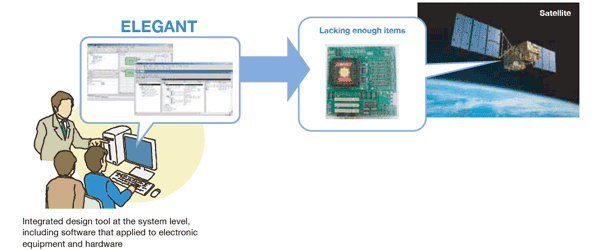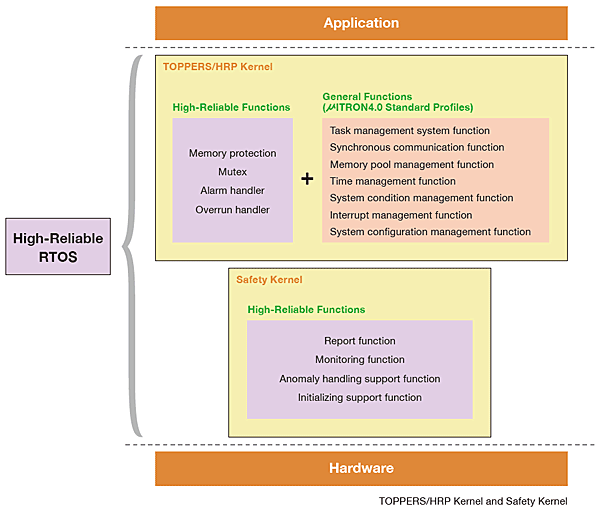ELEGANT / RTOS

1. Design Aid System for Space Electronics: ELEGANT
Electronic equipment for spacecrafts such as space stations, satellites and rockets have two portions. One is the analog portion composed of capacitors, resistance and others and the other is the digital portion composed of hardware (HW) represented by FPGA and ASIC and software (SW) run on CPU and others.
The HW and SW of the digital portion used to be designed in different environments by different persons. Therefore, some problems occurred like the following: role sharing between HW and SW for processing wasn¡Çt suitable; a waiting period before SW testing occurred because SW testing could not be performed until HW designing was completed; and in the combination test of HW and SW, sufficient SW testing was not conducted for fear of the HW crashing.
Therefore, in order to contribute to the reduction of design period and improving reliability by solving those problems, we developed the ¡ÆDesign Aid System for Space Electronics: ELEGANT (Electronic Design Guidance Tool for Space Use)¡Ç . ELEGANT enables that HW and SW of the digital portion to be designed in the same design environment by the same person. It refines processing in stages and allocates roles to HW and SW. Furthermore, trial and errors may be repeatedly conducted on ELEGANT since simulations can be conducted at various stages, making the optimization of division of roles between HW and SW possible. Also, it enables severe SW testing by use of a simulated HW in ELEGANT rather than using the actual HW which may break down during tests.
ELEGANT was completed in fiscal 2007 and has already begun to be used for development of the communication equipment of satellites. It also can be used for the designs of electronic equipment for cars, digital home electronics and other consumer electronics. We are proactively trying to expand its utilization for the designing of such equipment.

¡ÚFPGA¡ÛField Programmable Gate Array
¡ÚASIC¡ÛApplication Specific Integrated Circuit
2. High-reliable Real Time OS, ¡ÆTOPPERS/HRP Kernel and Safety Kernel¡Ç
Real Time OS (Real Time Operating System: RTOS), which is a basic software, is becoming more important owing to the expanding scale and increasing functionality of software for spacecrafts. Although reliability improvement of RTOS is an urgent problem common to every type of software that requires reliability, not only for spacecrafts, the software industry has not yet tackled the challenge earnestly enough. As part of this challenge, our team conducted research on the verification method for RTOS in advance of the software industry, applied it, and developed the High-reliable RTOS, TOPPERS/HRP Kernel and Safety Kernel. The outcomes of cooperative research with Nagoya university have been used for TOPPERS/HRP kernel.
At the research on the verification method, firstly, we have widened the area other than spacecrafts (e.g. aircrafts, railroads, medical equipment, etc.). We are investigating software development standards and guidelines, organizing the types of verification required for software and have compiled verification requirements specific to RTOS. Next, we discussed how to run tests to satisfy such verification requirements and have put together a process that combines a method of validating specifications and functions without fail (exhaustive test) and a method of testing areas that are suspected of causing problems (pinpoint test).
TOPPERS/HRP Kernel and Safety Kernel have the ability to contribute to improving the reliability of the entire space equipment system since it has a function of preventing the failure occurring in one software from affecting the other software. This Japanese RTOS has already decided to be adopted to the on-board computer of H-IIA rocket and H-IIB rocket. (As of September 1st, 2011, they have not had the achievement of flights.)


